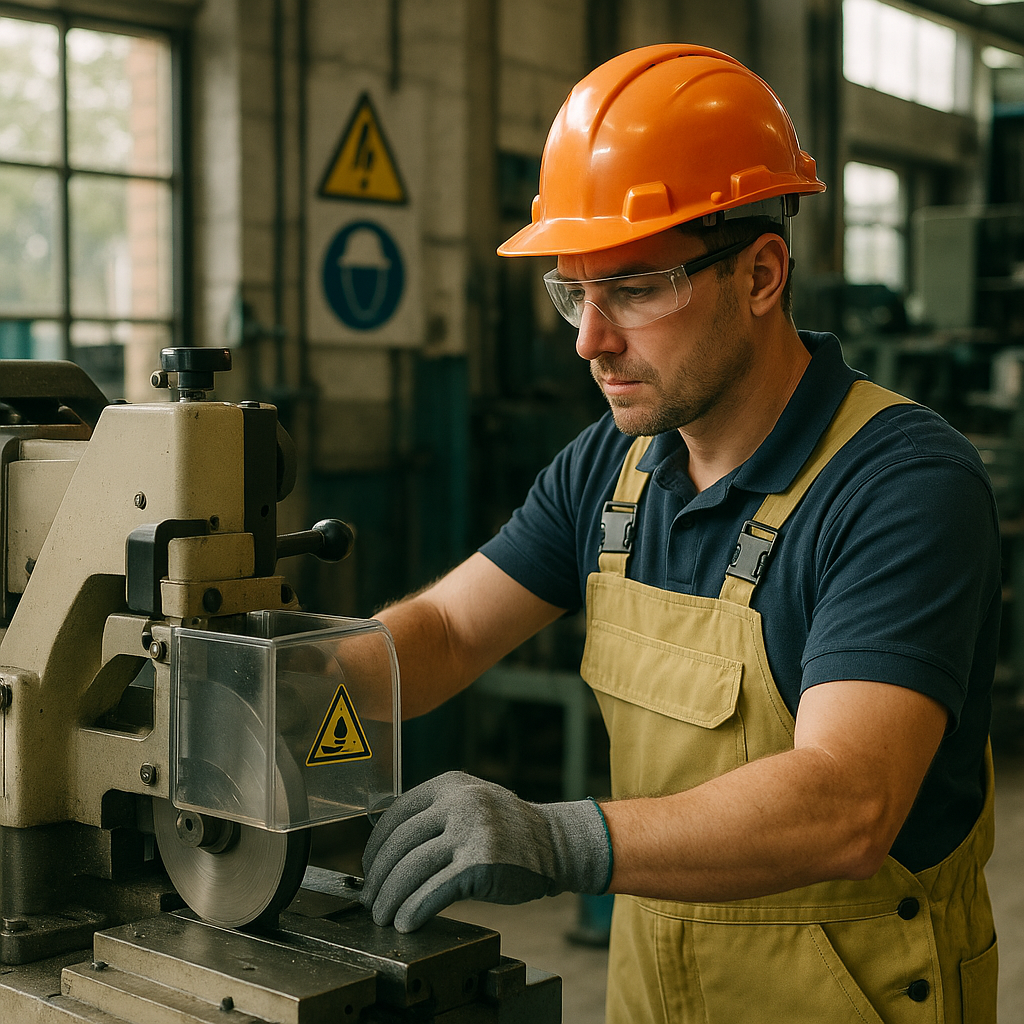5901 Botham Jean Blvd, Dallas, TX 75215
Key Safety Hazards in Metal Recycling: A Guide to Risks, PPE & Protocols
October 21, 2025Workers in the metal recycling industry experience injury rates more than twice as high as the average worker. This concerning statistic underscores the dangers inherent in an industry vital for sustainability. Metal recycling facilities contain numerous hazards that can lead to serious injuries or fatalities without proper safety measures.
Exposure to toxic materials is one of the most significant dangers in metal recycling. Workers frequently encounter heavy metals like lead, cadmium, mercury, and beryllium during processing. These substances can cause both immediate health effects and long-term damage to organs and body systems.
For instance, overexposure to lead is among the most common hazards in scrap metal recycling and can damage the kidneys, brain, and cardiovascular system.
What Personal Protective Equipment is Essential?
Working with scrap metal exposes employees to various physical hazards and potentially toxic materials. OSHA provides comprehensive guidelines for personal protective equipment (PPE) to minimize these risks. The right PPE forms a vital barrier between workers and workplace dangers.
Protective eyewear is a crucial requirement in scrap yards. Metal fragments, dust, and chemical splashes pose serious threats to vision. Workers should wear impact-resistant safety glasses with side shields or full-face shields during cutting, grinding, or crushing operations.
Steel-toed boots protect feet from falling objects and sharp debris. These boots should have puncture-resistant soles to guard against protruding nails or metal shards. Some facilities also require metatarsal guards for added protection against heavy falling objects.
Hard hats are necessary in areas with overhead work or moving equipment. Regular inspection of hard hats for cracks, dents, or degradation ensures they maintain their protective efficacy. Any damaged hard hat should be replaced immediately.
Heavy-duty gloves prevent cuts, punctures, and chemical exposure. Different tasks require specific glove types. Cut-resistant gloves are best for handling sharp materials, chemical-resistant gloves protect against harmful substances, and heat-resistant gloves safeguard hands during torch cutting or other hot work.
High-visibility vests ensure workers remain visible to equipment operators, significantly reducing the risk of struck-by accidents. Vests should be bright yellow or orange with reflective strips for maximum visibility.
Respirators are necessary when dealing with potential airborne hazards. Workers cutting or grinding metals may need protection from toxic dust. Those handling materials with chemical coatings or working near furnaces should have appropriate respiratory protection. Facilities must conduct proper fit testing for all respirator users.
Depending on specific tasks, additional PPE may include hearing protection, face shields, disposable coveralls, and fall protection equipment. Noise levels in scrap processing facilities often exceed safe thresholds, so workers near loud machinery should wear earplugs or earmuffs.
Regular PPE inspection is crucial for maintaining protective integrity. Workers should check their equipment before each use for signs of wear, damage, or contamination. Any compromised PPE loses its protective value and creates a false sense of security.
Employers must provide training on proper PPE use and maintenance. Workers need to understand how to don, doff, adjust, and care for their protective equipment. They should also know when equipment replacement becomes necessary.
Proper storage extends PPE lifespan and maintains effectiveness. Clean, dry storage areas prevent contamination and degradation of protective materials. Safety glasses should be kept in protective cases, and respirators require sealed containers to prevent filter contamination.
PPE Requirements by Hazard Type
Different scrap metal processing tasks present varying hazards. Workers handling lead-containing materials face specific toxic exposure risks, while those operating shears or balers encounter different mechanical hazards. Tailoring PPE selection to specific job functions maximizes protection.
When dealing with hazardous chemicals found in some scrap materials, chemical-resistant suits may be necessary. Cadmium, beryllium, and mercury require specialized protection protocols. Workers should never compromise on appropriate protective gear when handling known toxic materials.
The combined effect of multiple PPE items creates comprehensive protection. A worker using proper eye protection, gloves, boots, hard hat, and high-visibility clothing significantly reduces their overall risk profile. Each element addresses specific vulnerabilities.
Remember that PPE serves as the last line of defense after engineering and administrative controls. Proper ventilation systems, machine guarding, and hazard elimination should always be prioritized before relying solely on personal protective equipment.
The cost of quality PPE is minimal compared to the potential consequences of inadequate protection. Eye injuries, chemical burns, respiratory damage, and crushing injuries carry enormous human and financial costs. Investing in proper protective equipment represents sound business practice.
How Can Exposure to Toxic Materials be Minimized?

Limiting exposure to toxic metals and chemicals in recycling facilities is a critical priority. The primary defense is effective ventilation. Strategically placing ventilation systems near furnaces, shredders, and areas with airborne pollutants helps capture toxins at their source, preventing dispersion throughout a facility.
Local exhaust ventilation systems are more effective than general dilution ventilation for containing toxic materials. These systems trap contaminants at or near their source, similar to a vacuum cleaner, rather than allowing them to spread throughout the workspace. For facilities handling materials like e-waste that may release heavy metals or process items with chemical residues, local exhaust systems are essential.
The effectiveness of ventilation depends on proper system design and maintenance. Exhaust fans should be positioned close to contamination sources, with makeup air behind workers. This setup helps draw contaminated air away from breathing zones. Regular inspection and cleaning of ventilation components prevent buildup that could reduce efficiency.
Beyond engineering controls, comprehensive worker training is vital. Employees must understand the hazards of materials they handle, proper use of personal protective equipment, and early symptoms of toxic exposure such as headaches, dizziness, respiratory irritation, or skin reactions. Quick recognition of these symptoms can prevent more serious health effects.
Clear protocols for material handling are equally important. Facilities should implement systems for:
- Segregating incompatible toxic materials to prevent dangerous chemical reactions
- Secure containment using appropriate containers for specific waste types
- Proper labeling of all hazardous materials and waste
- Regular disposal schedules to prevent accumulation
- Documented cleanup procedures for spills or accidental releases
Compliance with EPA guidelines is not just a legal requirement—it provides a framework for protecting workers and communities. The EPA recommends a hierarchy of controls that prioritize eliminating or substituting hazardous materials when possible, followed by engineering controls like ventilation, then administrative controls, and finally personal protective equipment as the last line of defense.
Start implementing toxic material protocols with simple changes that have significant impacts. Storing partially used chemicals in well-sealed containers in ventilated areas can reduce exposure to volatile organic compounds significantly. Additionally, scheduling tasks involving toxic materials during periods with fewer workers can limit exposure.
For facilities managing particulate matter like metal dust or fibers, high-efficiency particulate air (HEPA) filtration systems should supplement general ventilation. These systems can capture microscopic particles that standard filters miss, offering additional protection for workers in recycling operations where cutting, crushing, or shredding creates airborne contaminants.
What Safety Protocols are Needed for Equipment and Machinery?
Comprehensive Training Requirements
Safe operation of recycling equipment begins with proper training. Workers must complete specialized instruction before operating machinery like industrial shredders, balers, and cranes. This training should cover basic operation procedures, recognition of potential hazards, and proper handling techniques.
Training programs must include both theoretical knowledge and hands-on practice. Operators need to understand load capacities, operating speeds, and emergency shutdown procedures. OSHA regulations require that only certified personnel operate heavy machinery like cranes, making proper certification an essential component of workplace safety.
At a Michigan recycling facility, a newly hired operator prevented potential equipment failure by identifying unusual vibrations in a shredder during his pre-shift inspection. His thorough training enabled him to recognize early warning signs of bearing failure, allowing for scheduled maintenance rather than catastrophic breakdown.
Essential Safety Features and Equipment
Modern recycling machinery should incorporate multiple safety mechanisms to protect operators. These features create layers of protection that prevent accidents and minimize risks in the processing environment.
- Emergency stop buttons strategically positioned for quick access
- Human detection sensors that halt operations when workers enter danger zones
- Safety interlocks on access panels and maintenance doors
- Physical barriers and guardrails around moving components
- Audible alarms that activate during startup or dangerous operations
- Proper guarding of pinch points, rotating parts, and cutting mechanisms
Personal protective equipment complements these engineering controls. Operators should wear cut-resistant gloves when handling materials, safety glasses to protect against debris, and steel-toed boots to prevent foot injuries. Fitted clothing without loose elements prevents entanglement in moving parts.
Maintenance Protocols and Inspection Schedules
Regular maintenance forms the backbone of equipment safety programs. A rigorous maintenance schedule helps identify potential problems before they result in dangerous malfunctions or accidents.
Daily inspections should be conducted before each shift. Operators must check for worn components, loose connections, and proper function of safety devices. These inspections should follow a standardized checklist to ensure consistency and thoroughness.
More comprehensive maintenance should occur on a scheduled basis, following manufacturer guidelines. This includes lubricating moving parts, checking alignment, and replacing worn components. Keeping detailed maintenance records helps track equipment condition over time and identify recurring issues.
Environmental Hazard Controls
Safety protocols must address environmental factors that affect machinery operation. Proper workspace organization prevents trip hazards and ensures operators have clear access to controls and emergency stops.
Fire prevention strategies are particularly important for shredders and other equipment that generates heat during operation. Fire detection systems should be installed to quickly identify flames or excessive heat. Some advanced systems include automatic suppression mechanisms that activate when fire is detected.
For crane operations, wind monitoring becomes crucial. Operations should cease when wind speeds exceed safe thresholds, typically 15-20 mph. Weather conditions should be continuously monitored during outdoor operations to prevent accidents caused by environmental factors.
Implementing comprehensive safety protocols protects both workers and equipment. The initial investment in proper training, safety features, and maintenance routines ultimately saves money by preventing accidents, reducing downtime, and extending equipment lifespan.
How Should Facilities Implement and Maintain Safety Protocols?

Safety management in scrap metal recycling requires a strong commitment to ongoing improvement. Success depends on creating a system that adapts to new regulations, technologies, and identified risks. Facilities that uphold the highest safety standards conduct regular audits to thoroughly assess all operational aspects. These audits should identify potential hazards before incidents occur and evaluate compliance with current regulations.
Documentation is vital in effective safety management. Facilities should maintain detailed records of incidents, near-misses, and corrective actions to track patterns and demonstrate progress. This information is invaluable when updating protocols to address emerging risks or regulatory changes.
Worker training is the foundation of any successful safety program. Training must be comprehensive, covering everything from proper handling techniques and equipment operation to emergency response procedures. This education should occur regularly, not just during onboarding, to reinforce safety principles and introduce new protocols as they develop.
Crucially, facilities must establish and practice clear emergency procedures. These protocols should address various scenarios, from equipment malfunctions to medical emergencies, with well-defined roles and responsibilities for all team members. Regular drills ensure everyone knows exactly what to do when time is critical.
Maintaining a safe scrap metal recycling facility is an ongoing journey. For expert guidance on establishing or enhancing safety protocols, contact Okon Recycling at 214-717-4083. Our team can help you create a comprehensive safety framework that protects your most valuable assets—your people.
